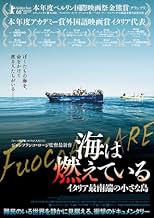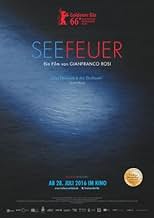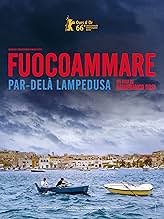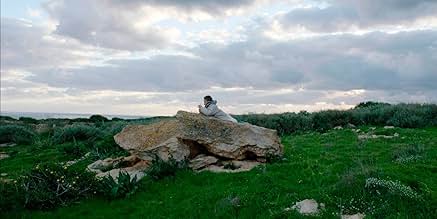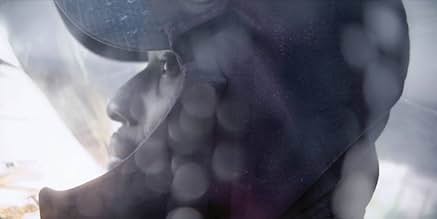Adicionar um enredo no seu idiomaCapturing life on the Italian island of Lampedusa, a frontline in the European migrant crisis.Capturing life on the Italian island of Lampedusa, a frontline in the European migrant crisis.Capturing life on the Italian island of Lampedusa, a frontline in the European migrant crisis.
- Direção
- Roteiristas
- Artistas
- Indicado a 1 Oscar
- 16 vitórias e 28 indicações no total
- Direção
- Roteiristas
- Elenco e equipe completos
- Produção, bilheteria e muito mais no IMDbPro
Avaliações em destaque
Documentary films can be known for have a harsh look given his nature of realism and objectivity, the visual element becomes secondary when it's Reality the substance of the discourse in the movie, and also having in mind the idea of the political possibilities that this tool offers is normal to think that aesthetics are not really relevant.
In this case, Fire at Sea achieves the perfect balance between both elements: Political statement or position from a very Objective point of view; and very beautiful visual development without affect to much the reality of happenings. We are talking about a spellbinding but bittersweet piece of work that it can really shock you both painfully and delightedly, it's captivating but thrilling at the same time a really must see feature.
And yet, that's exactly what director Gianfranco Rosi has tried to do in this documentary. He must have spent many months with the Italian coast guard, which tracks down the vessels with refugees. And he must have shot an immense quantity of footage, because it's clear he has selected only the best material.
The film doesn't explain or elaborate. It just shows, as a good movie is supposed to do. There is some very shocking footage, but also plenty of small, almost ordinary scenes like a beautiful shot of a helicopter taking off, or a doctor doing a check-up of a newly arrived refugee pregnant with twins.
But there are not only scenes of refugees. There is also daily life on the island, which we see through the eyes of a small boy. The contrast between the calm, uneventful lives of the boy and his family, and the utter despair and misery of the refugees, is what makes this film special. It also offers the viewer some relief from the grim scenes at sea. Some of the scenes featuring the boy are really funny, such as his visit to the doctor because of an imagined illness.
The editing of the film is great. There is a slow build-up, with scenes whose meaning is not immediately clear. But later on, things fall into place. The most shocking footage is shown near the end. Also, there is a very good balance between the rescue scenes at sea and almost poetic scenes of daily life on the island.
The film did show the comfortable orderly lives of the islanders and their comfortable homes, contrasting with the destitution of the migrants who have lost everything - their homes, jobs, family members and face an uncertain future after a hazardous and sometimes deadly journey, but other than the doctor, no one seemed particularly bothered.
Questions which were not answered, where are the migrants getting all the money for the journey, which seems to cost around $10,000 and more. Just the boat trip from Libya to Lampedusa costs between $1,500 and $850 depending on your place in the boat, and seeing as most of the migrants are from Central Africa, getting to Libya must cost ten times more. What are the smugglers doing with all their money which must run into hundreds of millions by now. Where is it being laundered. What is being done to catch the smugglers? Are the migrants really in peril and facing death, or are they being enticed by the people smugglers with false claims of a land of milk and honey. If the latter, why are they not writing (or phoning on the ubiquitous cell phones) to warn their friends and family not to come? Perhaps it is compassion fatigue, but as we saw the dead migrants being unloaded from the tiny overcrowded boat, I was reminded of the cry of 'Bring out your dead' in the days of the plague.
Você sabia?
- CuriosidadesDirector Gianfranco Rosi did his own cinematography again, but used for the first time an ARRI Amira camera, which he said allowed him to shoot in dark environments: "Sometimes it looked like we had an incredible amount of light. Technology helped me a lot on this film. Being able to work with this tiny camera by myself was an incredible tool." [2016]
- Citações
Nigerian Refugee: This is my testimony... We could no longer stay in Nigeria. Many were dying. Most were bombed... We flee from Nigeria. We ran to the desert. We went Sahara Desert and many died... Raping and killing many people, and we could not stay. We flee to Libya. And Libya was a city of ISIS. And Libya was a place not to stay... On the journey on the sea, 200 passengers died. They got lost to the sea. A boat was carrying 90 passengers. Only 30 were rescued, and the rest died. Today we are alive...
Principais escolhas
- How long is Fire at Sea?Fornecido pela Alexa
Detalhes
Bilheteria
- Faturamento bruto nos EUA e Canadá
- US$ 120.933
- Faturamento bruto mundial
- US$ 1.178.377
- Tempo de duração1 hora 54 minutos
- Cor
- Mixagem de som
- Proporção
- 1.85 : 1
Contribua para esta página


![Assistir a Trailer [OV]](https://m.media-amazon.com/images/M/MV5BNmQ3ZjU0NzktZWFmNi00YzMxLTg1N2UtMGM3ZTgwMDU3OWJlXkEyXkFqcGdeQXRodW1ibmFpbC1pbml0aWFsaXplcg@@._V1_QL75_UX500_CR0)


